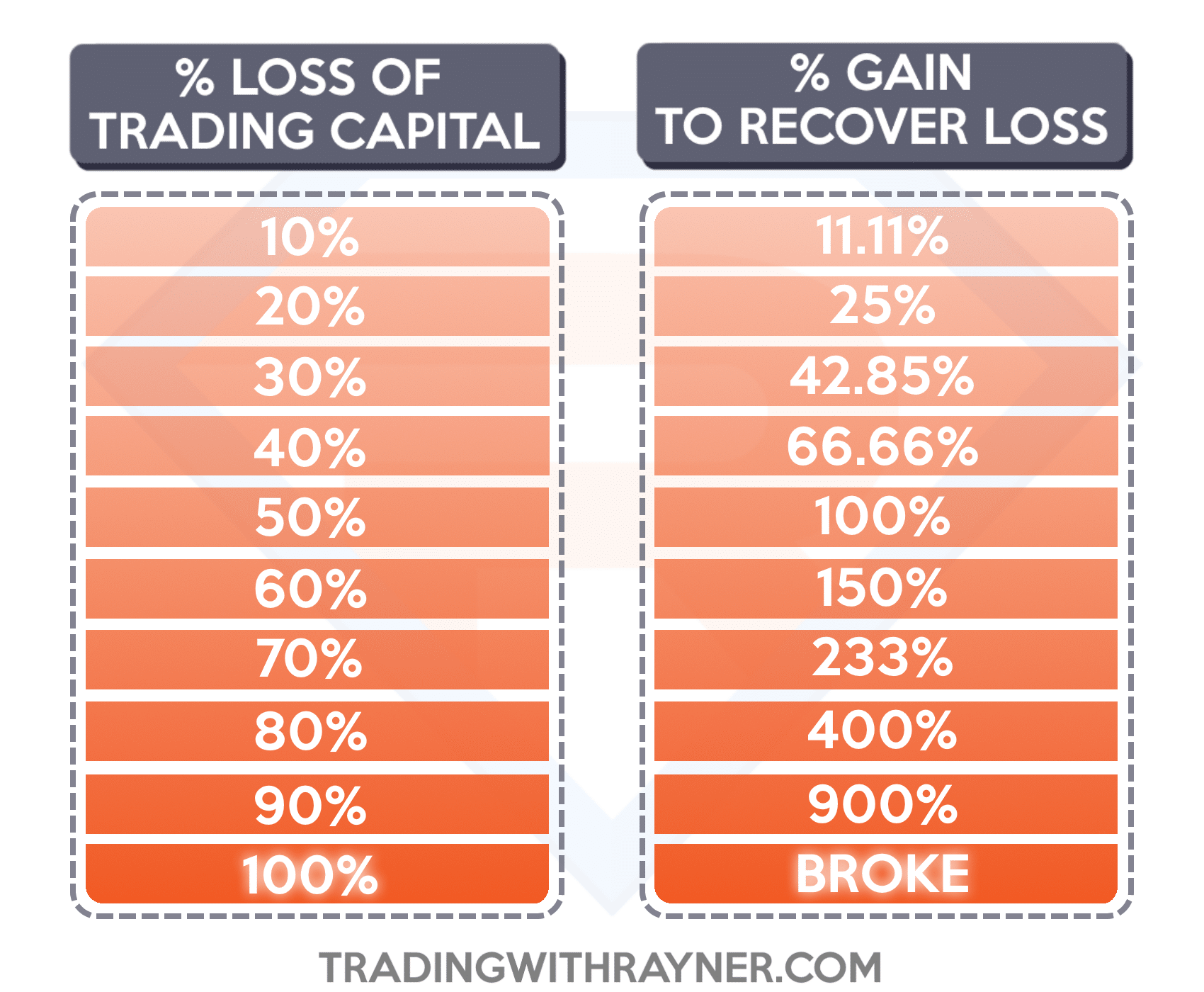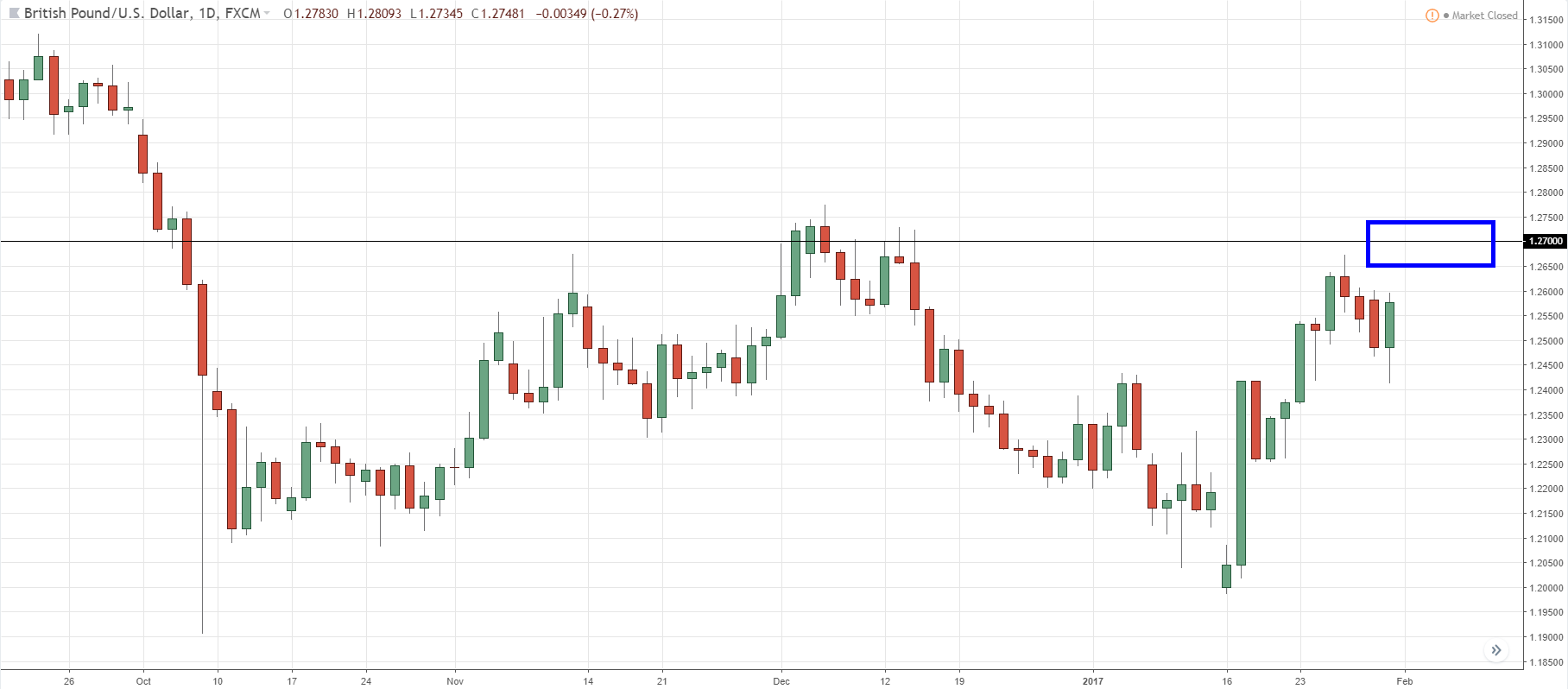
Forex risk management, what does it really mean?
Risk management is the ability to contain your losses so you don’t lose your entire capital. It’s a technique that applies to anything involving probabilities like Poker, Blackjack, Horse betting, Sports betting and etc.
Here’s the thing:
If you have a $10,000 trading account, would you risk $5000 on each trade?
Of course not.
Imagine:
There are two traders, John and Sally.
John is an aggressive trader and he risks 25% of his account on each trade.
Sally is a conservative trader and she risks 1% of her account on each trade.
Both adopt a trading strategy that wins 50% of the time with an average of 1:2 risk to reward.
Over the next 8 trades, the outcomes are Lose Lose Lose Lose Lose Win Win Win Win.
Here’s the outcome for John:
-25% -25% – 25% – 25% = BLOW UP
Here’s the outcome for Sally:
-1% -1% -1% -1% +2% +2% +2% +2% = +4%
Can you see how powerful this is?
Clearly, you should never risk too much per trade and definitely never go all-in on a single trade.
Now…
To further manage your risk, you can avoid trading during major economic events.
This way, you’ll avoid the volatility spikes that will easily whip you out of your trades.
The price pattern will also be clearer when there are no major economic events.
Risk management could be a deciding factor on whether you’re a consistently profitable trader or, losing trader.
Remember, you can have the best trading strategy in the world. But without proper risk management, you will still blow up your trading account. It’s not a question of if, but when.
What is forex position sizing and why it’s the closest thing to the “holy grail”
Position sizing.
A technique that determines how many units you should trade to achieve your desired level of risk. And this is the closest thing you can get to the “holy grail”.
But before you calculate your position size, you must know these 3 things:
- Value per pip
- The dollar value you’re risking on each trade
- The distance of your stop loss
1. Value per pip
Value per pip is the change to your P&L if price moves by 1 pip. To calculate this, you need three things: Currency of your trading account, the currency pair traded, and the number of units traded.
Example 1:
Your trading account is in SGD.
You’re trading EUR/USD.
You long 100,000 units of it.
Now…
If EUR/USD increases by 1 pip, what is the impact on your P&L (in SGD)?
Step 1: Determine the value per pip of the currency pair you’re trading
Since you’re trading EUR/USD…
The EUR is the base currency and the USD is the quote currency.
To determine the value per pip, look at the quote currency.
If you’re long 100,000 units of EUR/USD, the value per pip is $10USD.
Step 2: Determine the spot rate between the currency of your trading account and the quote currency
The currency of your trading account is in SGD.
The quote currency is USD.
Thus, look at the spot rate of USD/SGD.
Step 3: Multiply the spot rate with the value per pip of the currency you’re trading
Let’s assume the spot rate of GBP/USD = 1.25
So…
1.25 * 50 = 62.5USD
This means every 1 pip movement in EUR/GBP is worth $62.5USD to you.
Now to make your life easier, you can use this FREE pip value calculator that I’ve created for you.
2. The dollar value you’re risking on each trade
This means how much you’re risking on each trade (in terms of dollar value).
I suggest risking not more than 1% of your account per trade. Why?
Because you don’t want a few losses to put you in a steep drawdown, or wipe out your trading account. And not forgetting, you need proper risk management to survive long enough for your edge to play out.
Here’s how to calculate your dollar risk per trade:
Let’s assume you have a $10,000 account.
You’re risking 1% of your capital on each trade.
Here’s the math: 1% of $10,000 = $100
This means you’ll not lose more than $100 per trade.
Remember, the risk of ruin is not linear. This means the more money you lose, the harder it is to recover back your losses.

3. The distance of your stop loss
The final ingredient is finding out what is the size of your stop loss (in terms of pips, or ticks if you’re trading stocks and futures).
I’m not going into full detail on how to set your stop loss. But the way I do it is by placing my stop loss at a level where if it’s reached, it will invalidate my trading idea. If you want to learn more, go watch the video below:
If you ask me, risk management and position sizing are two sides of the same coin. You can’t apply risk management without proper position sizing.
Next…
You’ll learn how to calculate your position size for every trade, so you will never blow up another trading account. Let’s go!
How to calculate position size in forex
Let’s assume:
- You have a $10,000USD trading account and you’re risking 1% on each trade
- You want to short GBP/USD at 1.2700 because it’s a Resistance area
- You have a stop loss of 200pips

Forex risk management — position size formula
Here’s the formula:
Position size = Amount you’re risking / (stop loss * value per pip)
So…The amount you’re risking = 1% of $10,000 = $100
Value per pip for 1 standard lot = $10USD/pip
Stop loss = 200pips
Plug and play the numbers into the formula and you get:
Position size = 100 / (200*10)
= 0.05 lot (or 5 micro lots)
This means you can trade 5 micro lots on GBP/USD with a stop loss of 200 pips; the maximum loss on this trade is $100 (which is 1% of your trading account).
Now you’re probably wondering:
“Rayner, this is so cumbersome. Is there a faster way to calculate it?”
You bet.
All you need to do is use a forex position sizing calculator and I’ll explain more in this video…
Stock risk management — position size formula
Here’s the formula:
Position size = Amount you’re risking / (stop loss * value per tick)
So…
- The amount you’re risking is 1% of $50,000 = $500
- Value per tick for 1 share = $0.01
- Stop loss = 250 ticks
Insert these numbers into the formula and you get:
Position size = 500 / (250*0.01)
= 200 shares
This means you can trade 200 shares of Mcdonalds with a stop loss of 250 ticks. If it’s triggered, the loss on this trade is $500 (which is 1% of your trading account).
Remember, when you’re trading stocks, the price can gap through your stop loss — causing you to lose more than you intended. This is a common occurrence during earnings season.
Now…
I know this is a slow way to calculate your position size for stocks. That’s why you can use a position sizing calculator to make your life easier.
Why leverage is irrelevant and what you should focus on instead
This is one of the most common questions I get from traders…
“Hey, how much leverage do you use?”
If you are unfamiliar with the term leverage, it means how many times larger you can trade relative to your account size.
So, if you have 1:100 leverage and your account size is $1000; this means you can trade up to $100,000 worth of the underlying instrument (like stocks, currencies, futures).
But here’s the truth:
I don’t bother about leverage. Why?
Because it has zero relevance to your risk management.
Let me explain…
- Assume you have a $100,000 account
- You risk 1% of your account on each trade
- Value per pip for 1 standard lot is $10USD/pip
- Your stop loss is 50 pips on EUR/USD
So, how many units can you trade?
Position size = 1000 / (50 * 10)
= 2 lots
This represents $200,000 worth of EUR/USD, or in other words, a leverage of 1:2.
But…
What if your stop loss is 500 pips?
Again, apply the position sizing formula and you get…
1000 / (500 * 10)
= 0.2 lot
This represents $20,000 worth of EUR/USD, or in other words, leverage of 1:0.2.
Do you see my point?
In both scenarios, the maximum loss on each trade is $1000, even though you’re using different leverages. Why?
Because the leverage you use depends on the size of your stop loss. The smaller your stop loss, the more leverage you can use while keeping your risk constant. And the larger your stop loss, the less leverage you can use while keeping your risk constant.
So…
Don’t bother too much about leverage because it is largely irrelevant unless you don’t have a risk management and a stop loss method altogether.
Instead, focus on how much you can lose per trade, and adopt the correct position size for it.
WHERE TO CONTACT US
Website: https://forextrade1.co/
Twitter: www.twitter.com/forextrade11
Telegram: telegram.me/ftrade1
Facebook: www.facebook.com/Forextrade01
Instagram: www.instagram.com/forextrade1
YouTube: www.youtube.com/ForexTrade1
Skype: forextrade01@outlook.com
Email ID: info@forextrade1.com

